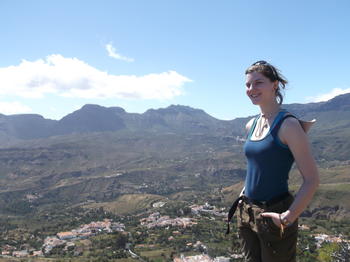Saskia Grund

Arbeitsbereich Mineralogie-Petrologie
Doktorandin
Raum L638
12249 Berlin
Professional experience
Since 11/2017
Doctoral student, Freie Universität Berlin.
04/2015 – 09/2017
Tutorin, Arbetisgruppe Tectonik und Sedimentäre Systeme, Freie Universität, Berlin
02/2014 – 04/2014
Internship at the Geological Survey of Finland, Espoo.
Sedimentological and chemical analysis of marine sediment drill cores from the Baltic Sea.
Ausbildung
10/2014 – 09/2017
Masterstudentin der geologischen Wissenschaften mit Schwerpunkt in “Geodynamik and Geomaterialien”, Freie Universität Berlin
Masterarbeit: “The fate of carbonates during natural impacts and laser-melting experiments – Implications for impact metamorphism of carbonaceous target rocks”
Gutachter: PD Dr. Lutz Hecht and Prof. Dr. Timm John
10/2011 – 09/2014
Bachelor student in Geological Sciences, Freie Universität Berlin
Bachelorarbeit: “Petrography and sedimentology of selected sandstones of the westernmost Dycedale Syncline, Barberton Greenstone Belt, South Africa”
Gutachter: Prof. Dr. Christoph Heubeck and Prof. Dr. Michael Schudack
Current research interests
My PhD topic is about Lithium chronometry in HP/UHP rocks in the Western Gneiss Region in Norway and the establishment of new thermodynamically-based models for determining timescales of fluid-rock-interaction.
Lithium chronometry is a novel tool to examine the duration of fluid-mediated processes in general. The Western Gneiss Region represents a natural, large-scale laboratory to investigate the effects of fluid-rock interaction in subducted rocks perfectly. I will apply various analytical methods to my research program including e.g. stable isotope measurements by MC ICP-MS and combine these data with field and petrological data via numerical simulations. Merging numerical modeling of the petrological rock dehydration and fluid flow with the lithium chronometry will help to understand the duration of fluid release and fluid-rock interaction events. Combining these techniques will likely allow a step forward in understanding the mechanisms behind subduction-related earthquakes.
My research project is involved in a big scientific network including the German Research Center for Geosciences (GFZ) in Potsdam, the Museum für Naturkunde - Leibniz Institute for Research on Evolution and Biodiversity (MfN) in Berlin and the University of Oslo (UiO).
Peer-reviewed publications
Hamann, C., S. Bläsing, L. Hecht, S. Schäffer, A. Deutsch, J. Osterholz and B. Lexow (2018). The reaction of carbonates in contact with laser‐generated, superheated silicate melts: Constraining impact metamorphism of carbonate‐bearing target rocks. Meteoritics and Planetary Science, 53.8, 1644-1686.
Heubeck, C., S. Bläsing, M. Grund, N. Drabon, M. Homann and S. Nabhan (2016). Geological constraints on Archean (3.22 Ga) coastal- zone processes from the Dycedale Syncline, Barberton Greenstone Belt. South African Journal of Geology, 119.3, 495-518.
Conference abstracts
Hamann, C., L. Hecht, S. Bläsing and S. Siegert (2018). An integrated CL, SEM, and optical microscopy study of carbonate impact melts in the Ries suevites. European Planetary Science Congress 2018, Berlin, Germany.
Bläsing, S., M. Grund and C. Heubeck (2015). Petrography and Structural Geology of the westernmost Dycedale Syncline (Barberton Greenstone Belt, South Africa) - Implications for Archean tectonics and depositional environments. GeoBerlin, Annual Meeting of DGGV and DMG 2015, Berlin, Germany. Poster presentation.